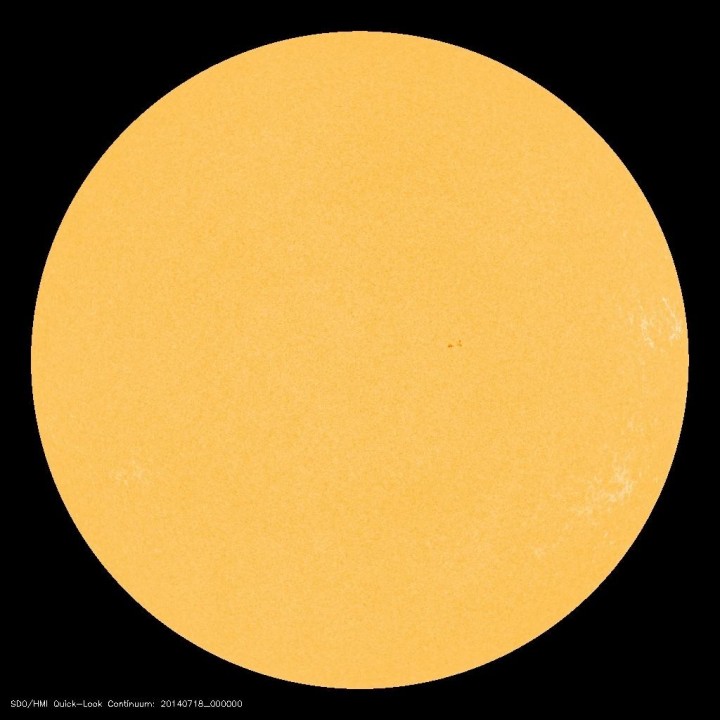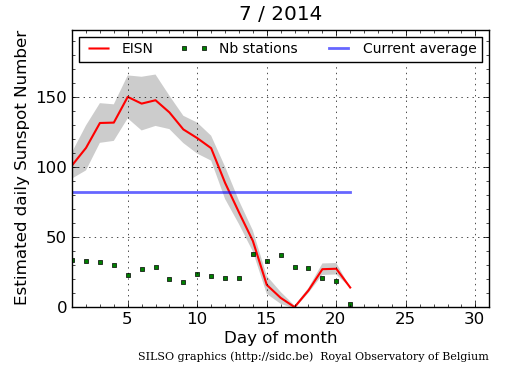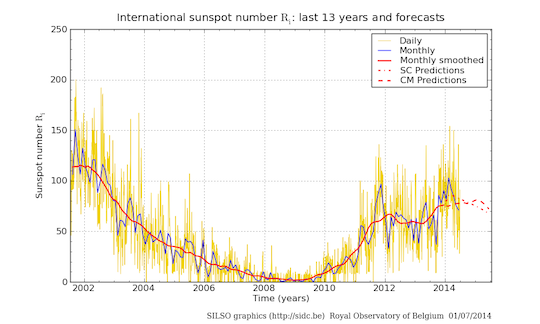It looks like you're using an Ad Blocker.
Please white-list or disable AboveTopSecret.com in your ad-blocking tool.
Thank you.
Some features of ATS will be disabled while you continue to use an ad-blocker.
share:
Where Have the Sunspots Gone? Spotless Sun Reveals 'Big Quiet' Event
www.ibtimes.co.uk...

THE SUN took a day off last week and made NO SUNSPOTS
www.theregister.co.uk...
www.ibtimes.co.uk...

For the last few days, telescopes aimed at the sun have detected very few sunspots experiencing an unusual phenomenon dubbed a "Big Quiet".
The event marks the absence of sunspots during what is supposed to be a heightened period of magnetic activity on our sun, which Swinburne University astrophysicist Dr Alan Duffy called a "very weird" development.
"Sunspots can change all the time, but when you should be seeing many dozens at any one point of time, it's quite strange that we're not seeing any at all," Duffy told the Sydney Morning Herald. "We don't have any idea why that is."
Sunspots are temporary phenomena on the photosphere of the sun that appear visibly as dark spots, compared to surrounding regions.
They are the region of the sun where solar activity originates when material is ejected into space following solar flares, sudden flashes of brightness and coronal mass ejections (CMEs).
Sunspots appear darker to us as they are caused by highly concentrated magnetic fields that are slightly cooler than the surrounding surface of the sun. Solar flares and CMEs occur when built-up energy is released.
The spots are one gauge of a solar cycle, an approximately 11-year period of above average or below average magnetic activity. Currently, the sun is in a maximum period, so observations of sunspots and solar flares should be more common.
Yet an image taken by Nasa's Solar Dynamics Observatory shows a distinct absence of sunspots, with just a small dot of brown just right of the centre where a small sunspot appears to be developing.
Speaking to the LA Times, physicist Tony Phillips, who writes about solar activity on his website Spaceweather.com, said it was not altogether that usual to have a Big Quiet event.
"It is weird, but it's not super weird," said Phillips. "To have a spotless day during solar maximum is odd, but then again, this solar maximum we are in has been very wimpy."
Phillips explained that we were currently in the weakest solar maximum to have been observed in the space age, so a spotless sun was not all that uncommon.
"It all underlines that solar physicists really don't know what the heck is happening on the sun," Phillips said. "We just don't know how to predict the sun, that is the take away message of this event."
THE SUN took a day off last week and made NO SUNSPOTS
www.theregister.co.uk...
The Sun seems to have given itself a few days off.
As noted by the Solar Dynamics Observatory, with reference to data from the Royal Observatory of Belgium's Sunspot Index and Long-term Solar Observations (SILSO) project, last Thursday July 17th saw the Sun produce no sunspots.
That's the first sunspot-free day since 2011. And as the graph below shows, Sol seems to be having a bit of a rest at present.
Before you rush to any conclusions about what this all might mean for the state of the Sun's climate, or Earth's, here's SILSO's longer-term look at sunspot activity.This graph shows a trend towards a dip, but also that low sunspot activity has recently been observed.
I find this subject interesting because it is an event that you don't hear about too often. Why does the sun take certain intermissions like this? Why
don't we see this on a more frequent occurrence?
I am not a true expert on this matter...but my questions to this event are:
Do sun spots block excess heat coming to Earth?
If so...then will a spotless sun increase the average temperatures on Earth?
I am not a true expert on this matter...but my questions to this event are:
Do sun spots block excess heat coming to Earth?
If so...then will a spotless sun increase the average temperatures on Earth?
edit on 21-7-2014 by Skywatcher2011 because: (no reason given)
The sun (Anu) holds his breath as he peers into the tragedy known as Earth and dares not breathe until there are assurances we do not blow ourselves
up and the planet/solar system with us.
edit on 21-7-2014 by Rosinitiate because: (no reason given)
So sun spots are cooler areas on the sun, which means the sun is running all hot right now because there aren't any cool spots....is that right?
The calm before the storm comes to mind. Just recharging before the kill shot......
Neutrinos are bombarding us like no tomorrow. Are we now in the "2012" or "Day After Tomorrow" narrative?
I haven't heard anything from Charley yet. Let's hold off pulling in the tomatoes until the report from YELLOWSTONE Pookie!
I haven't heard anything from Charley yet. Let's hold off pulling in the tomatoes until the report from YELLOWSTONE Pookie!
originally posted by: Skywatcher2011
I find this subject interesting because it is an event that you don't hear about too often. Why does the sun take certain intermissions like this? Why don't we see this on a more frequent occurrence?
I am not a true expert on this matter...but my questions to this event are:
Do sun spots block excess heat coming to Earth?
If so...then will a spotless sun increase the average temperatures on Earth?
Light yes.
Heat no.
Heat is a measure of kinetic energy. Sunspots occur when energy is released from the Sun's surface (solar wind electrons). Increase of sunspots actually means a greater number of electron streams are released out from the Sun's surface in the form of "solar wind". This "cools" the sun's surface where the electron stream originated, thus appearing black/dark or like a "hole/spot".
The "luminosity" (brightness) of the sun is increased with no "spots" present. But energy/heat/kinetic force is held inside the sun while is such a state. The release of this energy/heat/kinetic force out from the sun in the form of increased numbers of spots would increase heat inside Earth's magnetosphere.
More spots = cooler sun's surface = warmer Earth's magnetosphere.
Less spots = warmer sun's surface = cooler Earth's magnetosphere.
Transfer of energy; Law of thermodynamics.
God Bless,
originally posted by: Vasa Croe
The calm before the storm comes to mind. Just recharging before the kill shot......
It is the concern.
You want steady sunspots, because that keeps incoming solar wind levels steady and helps to stabilized any solar body system (like Earth).
When the sun stops releasing solar wind energy (no sunspots), much like a pimple, it can build up pressure underneath the surface. This build up could result is a major solar flare/CME; one that could be capable of the type of damage experienced over a century ago, and result in the manifestation of a certain "kill shot" scenario.
God Bless,
finally got over that bad case of acne. Seems to break out every so often. How embarrassing.
What do the electric universe guys have to say about it I wonder.....?
Dr. Tony Phillips says that a 'spotless day' is unusual but not unheard of. But he reports today on his website, that there have now been six
consecutive days with virtually no Sunspots.
www.spaceweather.com...
www.spaceweather.com...
In the long term, no correlation between sunspot numbers and climate ...

en.wikipedia.org...

en.wikipedia.org...
edit on 21-7-2014 by engvbany because: (no
reason given)
a reply to: stirling
No matter what the anomaly is, they usually claim it proves their "model", even if it doesn't.
This solar cycle is proving to be one of the more unusual cycles in recent times.
The sun went about 70 years without many sunspots from 1645-1715 during the Maunder minimum, so it's always possible we could have another such period though it's too soon to say if that's happening again:
en.wikipedia.org...

No matter what the anomaly is, they usually claim it proves their "model", even if it doesn't.
This solar cycle is proving to be one of the more unusual cycles in recent times.
The sun went about 70 years without many sunspots from 1645-1715 during the Maunder minimum, so it's always possible we could have another such period though it's too soon to say if that's happening again:
en.wikipedia.org...

The maunder minimum seemed to have some correlation to lower temperatures in Europe as did the other minimums of sunspot activity, but whether this was representative of global temperature isn't certain. The time scale of your graph is a lot longer and I don't even see the maunder minimum on it.
originally posted by: engvbany
In the long term, no correlation between sunspot numbers and climate ...
Like the Dalton Minimum and Spörer Minimum, the Maunder Minimum coincided with a period of lower-than-average European temperatures...
The Maunder Minimum coincided with the middle part of the Little Ice Age, during which Europe and North America were subjected to very cold winters.
edit on 21-7-2014 by Arbitrageur because: clarification
The best part of this thread is I have heard:
Sun Spots, Magnetoshpere, Solar Wind, Yellowstone, Doom Porn and PIMPLE all on the same page!
Gotta love diversity!
Sun Spots, Magnetoshpere, Solar Wind, Yellowstone, Doom Porn and PIMPLE all on the same page!
Gotta love diversity!
It is funny to think that Any scientist really knows what the sun will do
also as a reminder, 1859 Carrington event happened during a Minimum cycle.
also as a reminder, 1859 Carrington event happened during a Minimum cycle.
I'm confused. NASA tells us this sort of activity means cooler temps. The almanac says the same and I get that part. But it goes on to say increasing
gasses on earth may cause a warming trend. Solar radiation problems also increase with a quiet sun for satellites and astronauts but we hear this with
the other extreme too. Is it just extremes with the sun increase radiation? And how can gasses on earth override an inactive solar cycle?
"Quiet-to-average cycles mean a cooling pattern over the next few decades. Temperatures have been colder than it would have been otherwise. Sunspots are similar to a bathtub of lukewarm water; if you trickle in cold or hot water, it may take a while to notice the difference. If this cooling phase on Earth, however, is offset by any warming caused by increasing greenhouse gases, they also raise the question of whether an eventual warming cycle could lead to more rapid warming on Earth than expected."
m.almanac.com...
We had a super active sun the first two quarters. It's seemingly a bipolar sun this year.
m.almanac.com...
"Quiet-to-average cycles mean a cooling pattern over the next few decades. Temperatures have been colder than it would have been otherwise. Sunspots are similar to a bathtub of lukewarm water; if you trickle in cold or hot water, it may take a while to notice the difference. If this cooling phase on Earth, however, is offset by any warming caused by increasing greenhouse gases, they also raise the question of whether an eventual warming cycle could lead to more rapid warming on Earth than expected."
m.almanac.com...
We had a super active sun the first two quarters. It's seemingly a bipolar sun this year.
2014 Update: In the first quarter of 2014, the Sun starting heating up. February 2014 averaged 102.8 spots a day, which is the first time the cycle broke 100. March 2014 was also very high with 92.2 spots a day. More importantly, March set a record sunspot peak of 73.2 for Cycle 24 (versus the 68.9 record peak in February). In the second quarter of 2014, the sunspot number continues to rise toward a second peak and has now surpassed the first peak (February of 2012). Many cycles are double-peaked but this is unusual in that the second peak is larger than the first.
m.almanac.com...
I read about how, for the first time, last year they altered the axis of the ISS to get a better look at UV levels from the Sun, something was going
on I guess. Lately we have had UV ratings of 9 here in the Pacific NW, pretty high for us, though I have read of 15's in Texas and Australia, and up
a mountain in Bolivia, they had a reading of 43 or so. That is supposedly the value they will be dealing with on Mars, with its thinner atmosphere
letting in more solar UV. So what I wondered is the UV rating in space, or on the Moon with no atmosphere to block any UV? I don't see a simple
answer anywhere, I'm sure there must be an ATS member with an answer.
new topics
-
Electrical tricks for saving money
Education and Media: 38 minutes ago -
VP's Secret Service agent brawls with other agents at Andrews
Mainstream News: 1 hours ago -
Sunak spinning the sickness figures
Other Current Events: 2 hours ago -
Nearly 70% Of Americans Want Talks To End War In Ukraine
Political Issues: 2 hours ago -
Late Night with the Devil - a really good unusual modern horror film.
Movies: 4 hours ago -
Cats Used as Live Bait to Train Ferocious Pitbulls in Illegal NYC Dogfighting
Social Issues and Civil Unrest: 5 hours ago -
The Good News According to Jesus - Episode 1
Religion, Faith, And Theology: 7 hours ago -
HORRIBLE !! Russian Soldier Drinking Own Urine To Survive In Battle
World War Three: 10 hours ago
top topics
-
SETI chief says US has no evidence for alien technology. 'And we never have'
Aliens and UFOs: 16 hours ago, 8 flags -
Cats Used as Live Bait to Train Ferocious Pitbulls in Illegal NYC Dogfighting
Social Issues and Civil Unrest: 5 hours ago, 8 flags -
Florida man's trip overseas ends in shock over $143,000 T-Mobile phone bill
Social Issues and Civil Unrest: 12 hours ago, 8 flags -
VP's Secret Service agent brawls with other agents at Andrews
Mainstream News: 1 hours ago, 6 flags -
Former Labour minister Frank Field dies aged 81
People: 15 hours ago, 4 flags -
Bobiverse
Fantasy & Science Fiction: 12 hours ago, 3 flags -
HORRIBLE !! Russian Soldier Drinking Own Urine To Survive In Battle
World War Three: 10 hours ago, 3 flags -
Nearly 70% Of Americans Want Talks To End War In Ukraine
Political Issues: 2 hours ago, 3 flags -
Sunak spinning the sickness figures
Other Current Events: 2 hours ago, 3 flags -
Late Night with the Devil - a really good unusual modern horror film.
Movies: 4 hours ago, 2 flags
active topics
-
Cats Used as Live Bait to Train Ferocious Pitbulls in Illegal NYC Dogfighting
Social Issues and Civil Unrest • 12 • : Hakaiju -
HORRIBLE !! Russian Soldier Drinking Own Urine To Survive In Battle
World War Three • 28 • : budzprime69 -
Huge ancient city found in the Amazon.
Ancient & Lost Civilizations • 61 • : Therealbeverage -
The Reality of the Laser
Military Projects • 43 • : 5thHead -
VP's Secret Service agent brawls with other agents at Andrews
Mainstream News • 16 • : matafuchs -
Should Biden Replace Harris With AOC On the 2024 Democrat Ticket?
2024 Elections • 49 • : Therealbeverage -
WF Killer Patents & Secret Science Vol. 1 | Free Energy & Anti-Gravity Cover-Ups
General Conspiracies • 32 • : Arbitrageur -
Is there a hole at the North Pole?
ATS Skunk Works • 38 • : Therealbeverage -
SETI chief says US has no evidence for alien technology. 'And we never have'
Aliens and UFOs • 41 • : TheMisguidedAngel -
Naked Eye Supernova Erupting in the T Coronae Borealis
Space Exploration • 13 • : Therealbeverage


